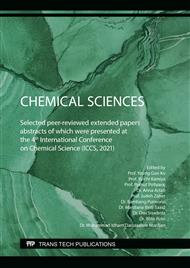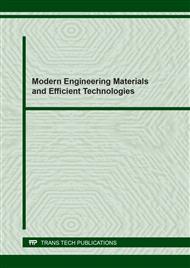[1]
A. Kumar, R. Pandey, N.J. Siddiqi, B. Sharma, Oxidative stress biomarkers of cadmium toxicity in mammalian systems and their distinct ameliorative strategy, J. Appl. Biotechnol. Bioeng. 6 (2019) 126–135.
Google Scholar
[2]
R. Renu, M. Agarwal, K. Singh, Heavy metal removal from wastewater using various adsorbents: A review, J. Water Reuse Desalin. 7 (2017) 387–419.
DOI: 10.2166/wrd.2016.104
Google Scholar
[3]
R. John, P. Ahmad, K. Gadgil, S. Sharma, Effect of cadmium and lead on growth, biochemical parameters and uptake in Lemna polyrrhiza L, Plant, Soil Environ. 54 (2008) 262–270.
DOI: 10.17221/2787-pse
Google Scholar
[4]
A. Hayati, K. Giarti, Y. Winarsih, M.H.F. Amin, The effect of cadmium on sperm quality and fertilization of Cyprinus carpio L, JTBB 2 (2017) 45.
DOI: 10.22146/jtbb.26744
Google Scholar
[5]
C. Prabhahar, K. Saleshrani, R. Enbarasan, Bioaccumulation of heavy metals in the muscles of grey mullet, Mugil cephalus in Kadalur coastal zone Tamil Nadu, India, Int. J. Recent Sci. Res. 2 (2011) 74–79.
Google Scholar
[6]
Ministry of Environment and Forestry of the Republic of Indonesia, Permen LH No. 3, Baku Mutu Air Limbah Bagi Kawasan Industri, (2010) 1–7.
Google Scholar
[7]
G.T.M. Kadja, M.M. Ilmi, Indonesia natural mineral for heavy metal adsorption: A review, J. Environ. Sci. Sustainable Dev. 2 (2019) 139–164.
Google Scholar
[8]
H. Sureshkumar, Removal of heavy metals from wastewater: A review, IJAIEM 4 (2015) 19–22.
Google Scholar
[9]
M. Abatal, A.V.C. Quiroz, M.T. Olguín, A.R. Vázquez-Olmos, J. Vargas, F. Anguebes-Franseschi, G. Giácoman-Vallejos, Sorption of Pb(II) from aqueous solutions by acid-modified clinoptilolite-rich tuffs with different Si/Al ratios, Appl. Sci. 9 (2019) 2415.
DOI: 10.3390/app9122415
Google Scholar
[10]
Ž.Z. Tasić, G.D. Bogdanović, M.M. Antonijević, Application of natural zeolite in wastewater treatment: A review, J. Min. Metall., Sect. A 55 (2019) 67–79.
DOI: 10.5937/jmma1901067t
Google Scholar
[11]
K. Margeta, N. Zabukovec, M. Siljeg, A. Farkas, Natural zeolites in water treatment – How effective is their use, in: W. Elshorbagy, R.K. Chowdhury (Eds.) Water Treatment, IntechOpen, London, 2013, 81–112.
DOI: 10.5772/50738
Google Scholar
[12]
M. İnce, O.K. İnce, An overview of adsorption technique for heavy metal removal from water/wastewater: A critical review, Int. J. Pure Appl. Sci. 3 (2017) 10–19.
Google Scholar
[13]
M.W. Munthali, E. Johan, N. Matsue, Proton adsorption selectivity of zeolites in aqueous media: Effect of exchangeable cation species of zeolites, Environment 2 (2015) 91–104.
DOI: 10.3390/environments2010091
Google Scholar
[14]
N. Katada, K. Suzuki, T. Noda, G. Sastre, M. Niwa, Correlation between Brønsted acid strength and local structure in zeolites, J. Phys. Chem. C 113 (2009) 19208–19217.
DOI: 10.1021/jp903788n
Google Scholar
[15]
M.W. Munthali, M.A. Elsheikh, E. Johan, N. Matsue, Proton adsorption selectivity of zeolites in aqueous media: Effect of Si/Al ratio of zeolites, Molecules 19 (2014) 20468–20481.
DOI: 10.3390/molecules191220468
Google Scholar
[16]
D.S. Syahiddin, A. Muslim, Adsorption of Cu(II) ions onto Myristica fragrans shell-based activated carbon: isotherm, kinetic and thermodynamic studies, J. Korean Chem. Soc. 62 (2018) 79–86.
Google Scholar
[17]
L. Anah, N. Astrini, Isotherm adsorption studies of Ni(II) ion removal from aqueous solutions by modified carboxymethyl cellulose hydrogel, IOP Conf. Ser.: Earth Environ. Sci. 160 (2018) 012017.
DOI: 10.1088/1755-1315/160/1/012017
Google Scholar
[18]
T.S. Khayyun, A.H. Mseer, Comparison of the experimental results with the Langmuir and Freundlich models for copper removal on limestone adsorbent, Appl. Water Sci. 9 (2019) 170.
DOI: 10.1007/s13201-019-1061-2
Google Scholar



